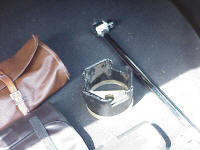Knockoff Socket Adaptor
There are a couple of knockoff tools on the market, but they are relatively expensive. Here's one from Seaport Mold and Casting. It uses a regular 1/2" torque wrench with an extender made from a 3/4" T-handle available from Sears. The combination of the two requires about 190 ft lb on the torque wrench to apply the correct 325 ft lb to the knockoff.
Since I now need two (one for the 330 and one for the PF coupe), I decided to make a couple. I determined that I didn't need anything with flat sides like the one above. I simply needed to use a piece of pipe of the correct diameter. When I measured the knockoff, I found that a 4" ID would work. I made an example from some 4" PVC pipe to determine the other dimensions. The one thing I didn't like about the Seaport one was that it didn't stick out very far, so you had to be careful to not hit the fender with the torque wrench. I decided that I wanted mine to be 5" deep.
A stop at a specialty metal place yielded a 3' long piece of stainless steel pipe with an ID of 4" and 1/4" wall thickness.
I also had some 1 1/2" x 1/2" stainless bar that I could use for the 3/4" socket. Lowell Brown took a piece of this and spent a couple of hours to cut two square holes using a milling machine and finally a file to square up the corners. I then cut the bar into the two pieces with rounded ends so it would fit into the pipe.
The wood jig kept the bar perpendicular to the band saw blade and helped prevent it from rotating. Each cut took about 10 minutes of hard pushing. My neighbor Mike used his TIG welder to weld the pieces with the socket hole into each pipe section.
Then I marked the locations to cut out between the tabs on the other end. The cuts parallel to the pipe were made using the band saw. I used a cut off wheel to go between the parallel cuts.
Once those cuts were made, I used a Sawzall to cut clear to the corners and remove the metal between the tabs.
The last thing to do was rounding the tabs where they contact the knockoff ears and dip them in some plastic material to help protect the ears. I first thought that I would fit the tabs to the shape of the ears. But then I realized that you would need one tool for the left side knockoffs and another for the other side. So much for that idea. Here they are after being dipped in Plasti Dip.
I had bought a 3/4" 600 ft lb torque wrench on eBay. This works well with my adaptor and I don't have to worry about the swiveling of an extension at the end of a 1/2" torque wrench. Here's everything in action.
One of the problems with my initial design was that there were no lugs to catch behind the knock-off ears to help hold the socket in place. This wasn't a problem when my wife was alive as she could always provide a knee to hold the socket tight against the knock-off. Without these lugs, it is difficult for one person to keep the socket from slipping while leaning on the end of the torque wrench. So I went back to my neighbors and sawed off a ¼" thick ring. Then we welded it onto the ends of the tabs. One section was kept intact while the other two were cut just enough to let them slip over the knock-off when the intact section was fit over the most vertical ear. Now it is quite easy for one person to remove or install a knock-off. Further, one is much less likely to have the torque wrench slip while near some body work.
